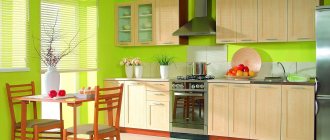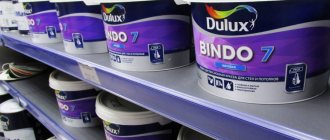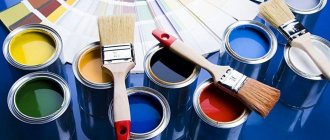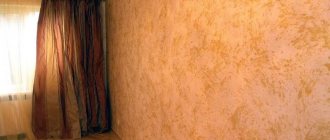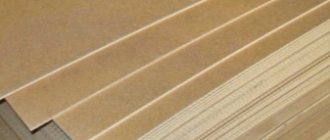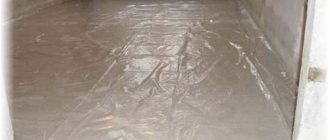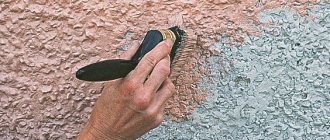Finishing materials are constantly changing. Wallpaper has been replaced by paint for the walls in the apartment in its variety of colors offered and with different characteristics. For the interior, they choose environmentally friendly, without a strong odor and allowing the walls to breathe. Waterproof, easy to clean coating in the kitchen and wet areas. In the hallway and corridor it is appropriate to protect the walls with an anti-vandal compound.
Advantages, characteristics and types
Painting walls allows you to create a unique interior in which the owner embodies his tastes and concepts of comfort. A room on the north side can become warm and sunny, thanks to hot tones, a small one will be visually enlarged. Paint for walls in an apartment, how to choose the right one for the kitchen with its steam and the children's room, where people who like to paint on all surfaces live.
The material for coloring has its positive aspects:
- huge color palette;
- easy to combine;
- the ability to decorate in various ways;
- quick and easy application method;
- does not tempt animals to peel and scratch to the same extent as wallpaper;
- durable surface;
- convenient to cover complex surfaces, niches, arches;
- allows you to quickly change the style of the room.
The disadvantages include preparing the surface for painting; puttying and cleaning require special skills, time and expense.
The choice of paint for walls in an apartment should take into account its characteristics:
- Covering power - how many layers need to be applied to obtain an even color.
- Drying and polymerization time.
- Vapor permeability is the ability of walls to breathe after painting.
- Thixotropy is the ability of paint to change thickness during application. Good quality for beginners, practically no drips are formed.
- Environmentally friendly - the composition does not emit harmful substances.
- Moisture resistance – washable.
- Smell.
- Application method: brush, roller, spray.
Manufacturers offer a large selection of different finishing materials. Popular types of interior paints have a base:
- oil;
- silicate;
- alkyd;
- nitrocellulose;
- water
Quick-drying paint - NC (nitrocellulose), used in Khrushchev-era buildings for painting floors and panels, has now been abandoned. It dries quickly, allowing you to do cosmetic repairs in a weekend. But its smell can poison apartment residents and neighbors for several more days. By repelling water, the surface quickly loses its shine and wears off, requiring constant renewal. A durable film of hardened nitrocellulose prevents the walls from breathing and promotes the appearance of fungus.
What paint is better to paint the walls in an apartment to create comfort and a healthy living climate? In each case, it is necessary to select individually.
Technologies for material preparation and application
Having understood the types of paint, let's look at how to properly apply them to walls. Both quality and appearance will depend on proper preparation.
Tinting of the composition
Water-based paints are sold either in white or in a limited range of colors. The main variety of shades is achieved through tinting - the process of adding colored pigment to white paint. These additives are produced by the same companies and can be combined with each other to obtain the desired shades. Full compatibility of materials is guaranteed only by the joint use of products from the same brand.
Tint card
Tinting can be done independently, or using a special computer-controlled installation. The second preparation option is not cheap, but the system itself will do the pigment dosage, thoroughly mix and produce the finished product of the same tone. This approach should be used when large areas need to be painted, and one bucket of paint will not be enough.
For small amounts of work, you can arm yourself with a mixer and do everything yourself, achieving the desired shade. At the same time, remember that the paint in liquid and frozen form will differ in shade saturation. Most often it becomes lighter after drying, although there are exceptions. Therefore, do not rush to pour in all the color and before painting the walls, do a test paint on a piece of the same drywall, let it dry, and only then check the shade.
We will also give you some practical advice: mix the entire volume of paint with the color. It is not worth dividing into portions for the reasons already stated. It’s better to apply one extra layer or get a remainder that may still be useful, than not have enough paint for 1 square and then have to repaint everything again.
Paint tinting process - mixing is done with an electric drill
Of course, we cannot decide for a person what color to use, but we will give a couple of recommendations for its selection. Perhaps they will be useful to someone:
- Light walls in a room will visually increase its volume, while dark walls will do the opposite. Use this principle when selecting paint to create the desired effect.
- Match the tones of the ceiling and walls. If the first one is darker (with good contrast), the room will appear squat. If it is lighter, there will be a feeling of greater height.
- For bedrooms it is better to choose light, dim matte walls - beige, gray, blue, green. They will create comfort and will not once again disturb a person’s consciousness. For the active zone, on the contrary, rich and bright shades are suitable - orange, red in moderate quantities, yellow, azure. In the office or hallway, you can take something darker, which is dictated by the need to concentrate and the practical side of the issue.
- You should not use more than three primary shades in one room, otherwise it will create the impression of a color mishmash. It’s also not worth making everything monochromatic. Select the main area in the room to which you want to attract the viewer’s attention, using the laws of contrasts and color combinations. An example of this approach is shown in the following photograph.
What colors are used to paint the walls in the apartment - a combination of shades
Preparing the base
Before tinting the paint, you must carefully prepare the surfaces to be painted. In this chapter we will look at how to do this correctly.
- The finished wall should be smooth, level and clean. If there is old putty and plaster on it, check its condition for strength. Using a sharp spatula, go over the entire wall. Where delamination is found, the rough finishing materials are sanded down to areas with good adhesion.
- New walls are preliminarily plastered over the beacons, after which they are puttied in several thin layers until the surface of the required quality is obtained.
- If there is old whitewash on the walls, and it is cracked in places, you need to either remove it completely, or clean the problem areas, which are then smoothed out with putty. New paint will not adhere well if the old one is of a different type. Chalk whitewash is washed off from the surface with water. The limescale is cleaned off mechanically after it has been thoroughly wetted. Water-based paints can also be removed with a spatula after preliminary impregnation, but with hot water or deep penetration acrylic primer. Paints based on organic solvents are removed with special removers, when heated with a hairdryer or with a hammer drill, together with the plaster.
- A better quality surface is obtained when it is completely puttied. For partial repairs, it is necessary to smooth out the edges - cracks may appear in these places over time. Therefore, whenever possible, we process the entire wall.
- When putting putty on the walls, it is necessary to smooth out the unevenness visible to the eye and fill in the depressions and cracks. During work, you need to organize oblique illumination of the surface to detect problem areas.
Cracks in the plaster appeared due to too rapid removal of moisture from the composition
- The wall should be examined for cracks. If this is obvious damage from deformation of the house frame, preliminary repairs and sealing are carried out. To do this, the crack is expanded to the depth of the plaster, and thorough cleaning of dust and priming is carried out. Next, reinforcement is installed - depending on the degree of damage, fiberglass mesh, special paper, metal mesh and even steel staples can be used. Then everything is sealed with a repair compound, and the surface is puttied.
- If the cracks are like in the photo above, there is no need to repair them, since they appeared because the wall was poorly primed before plastering, and moisture from the mixture was quickly absorbed into it. Here you will have to putty 1-2 more layers than would be required for a high-quality wall.
- The final stage is grinding the surface. Abrasive treatment will make the walls as smooth as possible. For this work, hand and electric tools are used.
Sanding the wall
Do I need to prime the wall before painting? A difficult question to which there is no clear answer. In theory, this process is necessary, but...
- You need to use the same type of primer as the paint, otherwise it will only make things worse. Adhesion will decrease and the paint will apply unevenly.
- When applying primer, drips form. Visible marks remain in these places, and the wall itself absorbs water more slowly. As a result, after applying the paint, these marks will remain noticeable. Applying several layers does not help either.
If the surface is prepared correctly and the putty adheres securely, it is better to paint directly over it, after only cleaning it first.
Painting the walls
To work you will need a simple set of tools:
- Roller with medium length pile;
- Ditch for convenient dipping of the tool into paint;
- Small jar;
- Brush for painting hard-to-reach places;
- A hammer drill, electric drill or screwdriver combined with a mixer attachment when tinting is required manually.
Painter's tool
- Open the bucket of paint and check its thickness. If the composition seems thick to you, stir it with water, adding no more than 5% of the liquid from the total mass. Paint that is too thick will result in increased consumption.
Advice! Mixing of the paint is always carried out, since during its storage the substances in the composition separate, and it is necessary to make the mixture homogeneous.
Then we start painting - nothing complicated, but there are tricks:
- Drywall should be painted no earlier than 2 weeks from the moment the joints are puttied, since due to incomplete hydration in thick layers of gypsum, the surface may be painted unevenly.
- The work starts with painting the corners, for which a brush is used. You need to paint to a width of 4-5 cm, so that you can then reach the border with a roller.
- The roller is dipped into the tray, after which it rolls out on it. This is not done on the wall, as the coating will be uneven.
- Painting one layer of one surface is done without interruptions, otherwise when it dries, a border will form that will be noticeable.
- Carefully monitor the absence of drips and quickly roll them out.
- The first coat must dry for at least 1 hour before the second coat can be applied.
- Each subsequent layer is applied perpendicular to the previous one - this allows you to get rid of streaks.
- The last layer should be directed parallel to the rays of light falling from the window onto the walls. This way, the flaws that always exist will remain invisible.
Oil formulations
When oil paint is applied, it dries to form a durable, glossy film that does not allow air to pass through. The surface is not afraid of water. It can be washed with mild products and wiped dry. Otherwise there will be divorces. An oil-based coating quickly loses its gloss, and after 3 years it begins to crack and peel. Wipes off the floor and protruding corners.
When repainting without changing the color, it is enough to apply 1 layer. When changing from a dark color to a light, contrasting tone, up to 3 layers of coating are needed. When switching to other types of paint, the coating is removed down to the base. MA compositions are not compatible with other finishing materials.
All types of oil paints have one advantage - low cost. Their popularity is in the past. Other materials came to replace it.
The best latex compounds
The paint creates a film on the surface that can withstand moisture and has high strength properties. Suitable for rooms with high humidity. Stand out:
- “NewTone sky”, available in white, colors can be added. An excellent option for a room with a normal climate, suitable for any materials;
- “3DWhite” is suitable for dilution with water. Dries in 4 hours to obtain a matte finish;
- “Bindo 7 BW” is environmentally friendly, easy and evenly applied;
- “Retail Eurolatex7” stands out for its good hiding power and reasonable price.
Eco-friendly, easy and evenly applied.
Alkyd paints
When deciding what paint to paint the walls in the kitchen, you should consider alkyd compounds. They differ from oil paint because they have a natural base. Vegetable oils are treated with acids. The pigments, binders and consistency remain the same as in oil paints. When applied to the wall, white spirit and turpentine are used as a solvent, which quickly evaporate, but require the use of a respirator during work.
Alkyd compositions have a large selection of colors, are resistant to moisture and partially allow the walls to breathe. They are flexible and durable and wash well. They can be used in the kitchen and utility rooms. It is not recommended to use in bedrooms and children's rooms.
The best manufacturers of wall paints
It’s impossible to single out just one paint among all as the best. After all, paints are produced with different properties for different tasks. It is recommended to choose trusted brands; they pay great attention to the quality of the product.
There are several foreign brands - Dufa, Superweiss or Wandfarbe. Tikkurila and Sniezka are also popular. Among the domestic ones, it is necessary to highlight “Mizar”, “Admiral”, “Yaroslavskie Krasov”, “Nevskie Krasny”, “Eurolux”.
It is recommended to choose trusted brands; they pay great attention to the quality of the product.
Silicate durable coatings
Silicate compositions are based on liquid glass. They are used mainly outside and protect the facade from rain and weathering. In an apartment, they can be used in well-ventilated wet areas of bathrooms, kitchens, and boiler rooms. The strength and resistance to abrasion of silicate paint make it possible to preserve the walls in the hallway intact for a long time, where they are constantly exposed to impacts from bags and other objects.
The main advantage of silicate compounds is that fungus and mold do not form on them, and those that were already in the plaster layer die.
The disadvantage of silicate dyes is their low vapor permeability coefficient and limited color palette. The composition contains many alkalis that negatively affect the respiratory system. When painting, you must wear a respirator and do not enter the room until polymerization is complete. After drying, the silicate composition is harmless.
Tips for choosing
When choosing paint, you need to consider the following factors:
- if paint is needed for the hallway or other office spaces, then you should choose latex or acrylic paints;
- For rooms with high humidity (bathroom, kitchen), polyurethane or alkyd paints are suitable. They contain components that combat the appearance of living microorganisms, in particular against mold;
- matte water-based paints are used mainly for decorating bedrooms. The environmental friendliness of the paint is important here;
- for rooms with high humidity, choose silicone and silicate paints;
- latex paints are suitable for the most non-stainable rooms and areas, as they do not tolerate wet cleaning;
- Before buying paint, you should check its expiration date and the tightness of the container.
Color, texture and other characteristics depend on preferences and the desired result. If your own competence in the field of construction is not enough, as an option you should find out the opinion of specialist builders and finishers.
Interior wall paints
Advice! When purchasing paint for a child's room, it is recommended to pay attention to slate paints. They allow you to paint on the surface of the walls, and then are easily washed off with detergents. At the same time, the coating does not suffer.
If you look at the types of paints, then the optimal paints for interior wall decoration are:
- acrylic;
- decorative;
- water-based.
Among washable paints, the Dulux brand takes the lead. If you need fast-drying and unpretentious paints, you should choose brands such as Newtone, Benjamin or Dufa. If paint durability matters, then Tikkurila does an excellent job. In terms of odorlessness and environmental friendliness of the composition, the Alpine brand remains the undoubted leader.
Paint for interior use really deserves close attention, since it not only shapes the visual parameters of a home, but also actively influences the atmosphere in the house. High-quality paint retains its best qualities for many years. A bad choice, on the contrary, can make itself felt very soon: loss of external gloss, damage from mechanical influences or even from sunlight. Such factors force us to spend additional funds on restoration.
Video - How to choose wall paint
Graphite coating in a children's room
Graphite wall paint has the main qualities that distinguish it from other materials:
- high abrasion resistance;
- heat resistance.
The graphite included in the composition creates a rough surface on which chalk and felt-tip pens can draw well. The inscriptions can be easily removed with a damp sponge. The graphite mixture is harmless and can be used to paint walls in nurseries, create durable low panels in corridors and other places where the wall is constantly exposed to friction.
The second quality and good adhesion to metal and stone expand the use of graphite paint in places with high temperatures. It is used to paint stone and iron fireplaces, chimneys, and stoves. In addition to classic black, other colors of graphite mixtures for interiors are available.
Advantages and disadvantages of painting walls
Let's start with the advantages:
What immediately comes to mind is that with the help of paint you can realize any of your dreams of creating a specific color, since there are many options on the market, and all this is complemented by the ability to create shades at your own discretion;- with proper surface preparation, the finished coating will remain intact and intact for a long time, without cracking;
- It’s easy to remove stains and stains from a painted surface; most can be washed thoroughly without fear of damage;
- the paint will certainly not be of interest to pets, so there will be no scratches, like on wallpaper, for example;
- If a stain or defect has formed, it can be easily eliminated - you just need to tint it, i.e. there is no need to replace the entire coating, everything is simple, easy to do and inexpensive;
- if the room has complex elements, such as arches, ledges, etc., then painting the walls will be much easier than, for example, gluing wallpaper;
- You can repaint the walls or change the shade a little faster than if you want to re-glue the wallpaper.
The main disadvantages of painting walls include:
- the need for careful preparation of the walls so that the result is truly appropriate;
- at first glance, painting the walls is a mere trifle, but, in fact, an ideal surface is obtained only with appropriate preparation of the surface;
- many still believe that painting one color is boring and definitely not suitable for the home, but one can argue with this, because everyone has different tastes, and no one bothers painting one wall in a different color;
- paints, although resistant to mechanical stress, may not withstand a more or less strong blow to the surface;
- Almost all paints, except glossy ones, are capable of absorbing dust from the air.
Group of water-soluble compounds
Water-soluble paints are separated into a separate large group. They have different bases and binders. All formulations are soluble in water, do not contain harmful substances and are completely safe. If there are no material restrictions, then the question of what paint to paint the walls in the apartment should be decided in favor of water-soluble compounds. The choice of types is large:
- water-dispersed acrylic;
- silicone;
- latex;
- butadiene-styrene;
- water-based.
Water-soluble compositions have medium and high vapor permeability and allow the walls to breathe. After polymerization, their surface does not absorb water and many types of compositions can be washed.
Acrylic water-dispersion compositions
The most popular types of paints for walls in an apartment. They have a high cost, which is compensated by the positive characteristics of the material:
- easy to apply;
- good hiding power;
- does not fade;
- tightens cracks up to 1 mm;
- unlimited color palette;
- durable coating;
- washable;
- average vapor permeability.
In branded stores you can choose any shade you like from a card. It will be created using a tinting machine in a few minutes, and the buyer will receive the paint of the desired tone. For each color, the number of shades is in the dozens.
Silicone water dispersion
The ideal washable paint for kitchen walls is silicone water-dispersion. After drying, the wall can be washed any number of times with any substances except those containing abrasives. The surface is perfectly flat. Cracks up to 2 mm wide are healed. Good vapor permeability allows the walls to breathe and remove moisture out. Fungus and mold appear rarely. Does not fade in the sun. Resistant to abrasion.
Coverage is good, but working with silicone compounds requires skill. The cost is high. The decorative appearance lasts up to 10 years.
Latex water soluble materials
Latex paints for apartment walls are washable and are used mainly in the kitchen and hallway. Vapor permeability is good. The material is easy to apply and heals small cracks. When coated in 2 layers, a smooth and durable surface film is formed. The cost is average. Large selection of colors.
Disadvantages include sunburn and the difficulty of washing dried composition off the skin of your hands and metal tools.
Styrene-butadiene dyes are analogous to latex dyes, with a synthetic base component. Styrene butadiene is a type of artificial rubber. Low cost and high adhesion allow them to be used as a primer and base for light water-soluble compositions.
Compositions based on polyvinyl acetate
Water-based paint was the first water-soluble paint to appear in stores. Its base is polyvinyl acetate, better known as PVA. Advantages of the material:
- easy to apply;
- washes off hands and tools with water;
- compatible with all water-soluble compounds;
- tinted in any color;
- dries quickly;
- has no smell;
- low cost.
Water emulsion has more disadvantages than expensive analogues:
- turns yellow quickly;
- afraid of water;
- poor abrasion resistance;
- cannot be washed.
I need paint for drywall, which one to choose. Water-based one works well. It allows moisture to pass through itself, which the gypsum absorbs and releases back if the air is dry. Under it, you can use PVA glue diluted with water as a primer.
Water-based paint is an odorless, quick-drying, environmentally friendly wall paint. It can be used to paint walls in bedrooms and living rooms.
What paint to paint the walls in the apartment?
What paint to choose for the walls?
For rooms with high humidity and risk of fungal infection, use waterproof alkyd or polyurethane paints for kitchen and bathroom walls. Latex or acrylic water-based emulsions are also suitable.
For bedrooms, choose matte options, pastel colors or combinations thereof.
Decorated patterns, combinations of matte and glossy surfaces of the same color, highlighting corners and niches with contrasting shades will look good in living rooms.
For children's rooms, bright wall paints with a glossy surface, easy to clean and safe for health, are suitable. Latex and silicone water-based emulsions will cope well with these tasks.
Hallways are painted with dark glossy compounds in the lower part and light matte ones in the upper part. Any type of water-based emulsion is suitable, depending on the surface of the coating.
Decorative textured compositions will perfectly brighten up uneven corners and walls.
Important! Use only paints and varnishes intended for painting indoor walls. Ceiling, floor, facade and even universal paints may not have the necessary properties, thereby worsening the quality of the repair and your expectations.
The best painting materials for apartment walls today are latex and silicone water-based compositions.
Which manufacturer should you prefer?
Paintwork materials from numerous manufacturers are on sale. To paint the walls in an apartment, it is better to choose compositions from well-known brands. Moreover, most of these companies also produce inexpensive ranges of paints and varnishes.
Finnish paint compositions have shown themselves to work well (for example, acrylic compositions “Euro-2” and “Euro-7”).
Excellent results are obtained by painting walls with German compositions.
Compositions from manufacturing companies “Superweiss” and “Wandfarbe” are very popular among craftsmen.
Paintwork materials of the brands “Mokke”, “Snezhka”, etc. are often used.
Among domestic manufacturers, coating materials for interior walls, Admiral, Nevskie Krasov, Yaroslavskie Krasov, etc. are popular. The products of these companies are of good quality and reasonable prices.
In any case, consult with professionals before purchasing new paint.
How to choose the right paint color?
The selection of colors is an individual matter and there are no clear rules.
When choosing a color palette, we are guided by the following principles:
- in darkened rooms use light colors;
- in rooms with bright sunlight, it is preferable to paint the walls with UV-resistant paints. Shades of yellow, brown, orange, and gray are permanent colors. Purple and blue tones fade quickly;
- For bedrooms, calm colors are preferable: pink, blue, light green;
- For children's and living rooms, bright combinations of several types of paints on the wall are suitable.
For the ideal selection of color palette compatibility, designers created tables. They contain a color scheme that will be combined in one room. Such tables will help create a harmonious interior.
Unique anti-vandal coating
Currently, German manufacturers have produced anti-vandal paint for walls. The transparent coating is applied to the painted and any other surface in 2 layers. After drying, the felt-tip pen and spray paint are easily washed off the wall. Even glue does not stick to a surface with zero adhesion.
The composition is intended mainly for facades. Can be applied to poles and fences. If there are a lot of painters in the apartment, anti-vandal coating will be useful to preserve the walls and nerves.
Types of paints for painting walls in a room
Among the wide range of products for indoor renovation work, construction experts distinguish two types of paints.
- Alkyd: oil, drying oil, semi-matte, glossy, matte (subtype of gloss level), enamel, varnish.
- Emulsion: polyvinyl acetate, acrylic, silicate and silicone.
Alkyd paints are paints based on drying oil or alkyd resin. These components have a pungent odor. Considered hazardous to human health. There are many disadvantages, but there is one advantage - excellent surface protection from moisture.
Emulsion painting compositions are used for interior and exterior work. In contrast to previous materials, they do not contain foreign odors, dry quickly and offer an unlimited number of shades, colors and combined compositions.
There are 4 main brands of drying oils on the market with various properties and characteristics: MA-021 (film-forming drying oils), MA-025 (combined), GF-023 (griftal), PF-024 (pentaphthalic drying oil).
Popular manufacturers
The list of manufacturers of wall materials is large. Each company has its regular customers. Tikkurila wall paint is in demand due to its optimal price-quality ratio. The company produces all types of materials, from dry mixtures to paint and varnish products. It's easy to select finishes and cladding on one base.
Good quality is noted by experts from the companies Knauf, Starateli, Ceresit and other companies. Every person, starting a renovation, will be able to find exactly the wall paint that he likes, which will convey his character and mood.
Results of paint selection
For dry rooms we use water-based interior paint CAPAROL Samtex 3 matte paint, which is well suited even for those who have no experience in painting walls. Perfect for walls and ceilings prepared for painting with putty, covered with wallpaper, or covered with plasterboard. Samtex 7 is a slightly glossy option. These paints are positioned as water-based latex.
If you want a highly glossy effect, then Tikkurila Luja is best. Stunning glossy effect on any surface. A more matte version of Tikkurila Harmony.
If you decide to choose such branded paint, be sure to consult with the seller before purchasing. Don't bother with cheaper options. Manufacturers such as Oikos, Marat Ka, Viva Colo are on par with the recommended paints. By choosing cheap options, you sign up to repaint the surface every year, and possibly breathe in toxic emissions.
Much attention is needed to preparing the surface. The quality of the primer plays a big role. If the surface is well prepared, then the paint will adhere just as well. But how it behaves depends on the quality of the paint. Good paint costs $80 and up for 10 liters. And she can paint for her own pleasure. Of course it's up to you to decide.
Types of paints
The modern construction market offers a large selection of products; there are different types of wall paints with different component and chemical structures. The difference can be big, and not all varnish materials are suitable for interior finishing work. Let's look at the main types of wall paints and find out their properties. This will help in choosing paint for the walls in the apartment.
Oil formulations
These products are the most affordable on the market, but the resulting coating is considered the most short-lived. Dyes are based on mineral and vegetable oils. After application to the wall, the composition oxidizes, resulting in the formation of a film that prevents air circulation.
The composite is not resistant to almost all influences, and the coating quickly cracks. This material used for interior decoration will give poor results.
Alkyd paints
Alkyd compositions are similar in consistency to oil compositions. They are based on soybean, linseed and other oils, but also contain acidic and organic substances designed to increase wear resistance. These products are preferable for use in interiors. The film is durable and bright in color.
Paint brands such as Tikkurila and Element offer high-quality alkyd enamels, due to the elasticity of which the surface does not crack. The compositions are resistant to exposure to sunlight, moisture, and temperature changes.
These paints have their own characteristics. They are not recommended for use in residential areas due to low vapor permeability. Also, alkyd paints and varnishes have a strong odor, and finally, the product is highly flammable. If for certain reasons it is impossible to use other types of painting compositions, then alkyd paint is suitable for walls.
Silicate
This option is of better quality in its physical and chemical properties, but it is very difficult to find it on sale. The dye contains liquid glass. It provides the coating with high strength characteristics. The coating withstands mechanical and abrasive loads well. Due to the structure, good air circulation is ensured, the material withstands moisture, fungus and mold. The wall does not need any protective layer.
With all the advantages of this material, it has a lot of disadvantages. In a liquid, ready-to-use state, due to the high concentration of alkalis in the composition, the paint is aggressive to human skin and mucous membranes. When carrying out work, it is necessary to use protective equipment. After drying, the coating will become completely safe.
Pigments must also be exclusively alkali-based. This narrows the possibilities for independent tinting, and the choice of colors on sale is quite scarce.
These compositions will fit well only on mineral surfaces. If the wall has already been painted with organic dyes, then you should not use silicate dyes until the surface is completely cleaned. The silicate mixture will not adhere to metal and polymer surfaces.
If the wall was painted with silicate materials, then it makes no sense to apply anything else on top. If you need to repaint the wall, you will have to use silicate mixtures or completely wash off and clean the surface of the previous layer.
Water soluble
This is a large group of coloring compounds, among which you should choose a material for painting walls. These mixtures have one thing in common - they are diluted with water. The liquid contains all the necessary components. Among these components there are binding particles that create a dense layer. These elements may have different bases, but their only function is to fit tightly to the surface, as well as to securely hold the other components.
Coloring pigments determine the decorative characteristics of the dye. Additionally, there are additives and fillers, the functions of which may vary.
Acrylic
These paints are based on acrylic resins. They have many advantages: high elasticity, high strength, resistance to direct sunlight, good water-repellent characteristics. A special layer protects the walls from corrosion. The downside is the high price.
These paints are often chosen for interior decoration. The right color will allow you to qualitatively transform your interior.
On video: the advantages of acrylic paints.
Latex
The composition contains latex, which forms a powerful film with water-repellent properties. The paint dries quickly and is washable. Suitable for working on textured wallpaper and mineral surfaces. Able to mask minor defects on the wall. Considered the best option. You can easily choose paint by color - there are a lot of shades.
Water-based
It is a quick-drying and easy-to-apply material. The coating does not have a long service life, as it is washed off with water. Solutions have a wide selection of colors and shades, can be textured, and are strong enough to hide cracks and other defects. Among water-soluble types of wall paints, this is not the best choice.
Water-dispersed
The mixture is moisture resistant, the surface is washable. As for colors, only black and white are available. The remaining shades are obtained using tinting. The properties include good vapor permeability, so the compositions are used in damp rooms. The coating can withstand damage, but is afraid of low temperatures.
If choosing a specific paint is difficult for you, we can recommend MÖKKE interior paints. They are suitable for decorating walls and ceilings, and are universal for working on wood, brick and concrete. Equally safe for the environment and humans due to the absence of solvents in the composition. They are easy to apply and dry quickly, resulting in a perfectly smooth matte surface, without smudges or cracks. White MÖKKE paint is tinted individually.
Butadiene-styrene
This material is rarely found on the shelves of construction stores. Many people treat it with a certain degree of caution, and experts do not recommend them. Although the composition is one of the latex paints based on synthetic rubber, the coloring properties of this material are not high. The characteristics of paintwork materials are similar to water-based paint, but have greater resistance to abrasive influences and are not afraid of water.
This paint has one drawback - fear of light. When exposed to direct sunlight, the surface will quickly fade and lose its color.
Silicone
These are the most modern water-dispersed dyes. They combine all the advantages of each species included in the family. The products are completely universal and are the best paints for walls in an apartment. The material has excellent hiding power and the ability to hide small and large defects.
The paint creates a dense film, is not afraid of moisture and can be subjected to wet cleaning. As for manufacturers, German Caparol paint is recommended.
Polyurethane
In the production of this material, polyurethane resins are used, as well as special hardeners. These components are mixed immediately before use. The material is highly durable - its service life is more than 20 years. The price of the material is very high, but the surface can withstand any vibration, light, temperature and mechanical influence.
Acrylic paint
Pros:
- ideal for bathrooms;
- has no odor at all;
— lies on the surface with a moisture-proof film and is highly wear-resistant. You can safely rub it or wash it - the paint will remain in place.
Minuses:
- takes a very long time to dry, you will have to wait up to a month for complete drying;
- high price;
— a large number of fakes and low-quality goods are found with this type of paint.
Latex paint
Pros:
— this paint is based on latex polymers. Thanks to them, the painted surface will withstand almost any mechanical impact;
— it lies on the surface of the wall in a thin layer and is good for painting plaster or wallpaper, as it preserves their texture.
Minuses:
— latex paint is a “non-breathable” type, which is not useful for walls and ceilings in an apartment.
Oil paint
Oil paints are still in demand, but they are only partially suitable for interior decoration.
Pros:
— oil paints have good wear resistance. A layer of paint will remain on the surface for years. They are good for painting radiators in an apartment.
Minuses:
- oil base - drying oil, the paint takes a long time to dry and emits a strong specific odor that is harmful to children;
— the surface painted with oil paint becomes vapor-tight. In other words, it does not breathe and may peel off over time;
— applying this paint in one or two layers will not work: it not only streaks, but also does not give off pigment well (to get a bright and rich shade, you need to do at least three layers);
- walls painted with oil paint look unattractive.

